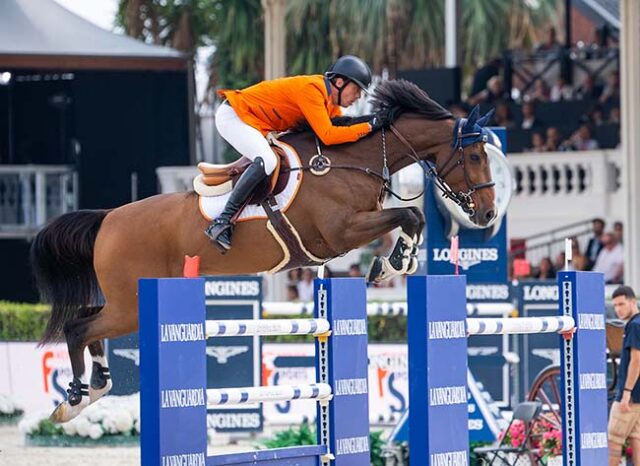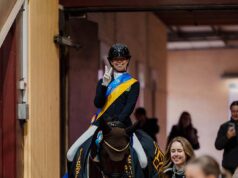
By Adriana van Tilburg
Photography: FEI/Shannon Brinkman, FEI/Lukasz Kowalski
The 13-year-old Holsteiner-bred gelding Monaco (Cassini II - Ulla II x Contender, Stamm 429, breeder: Ralf Lütje) has been creeping up the WBFSH rankings, taking over at the head of the leaderboard in May 2022.
The horse has been well managed by his Dutch rider Harrie Smolders, but what is Monaco’s back story? What are the origins of his motherline?
The Kahlke family from Rosengarten
In 1858 Jakob Kahlke took ownership of the mare Stern, born in Dithmarschen, who subsequently founded Holsteiner Stamm 429. Jakob Kahlke lived in Rosengarten, in the heart of Holsteiner breeding and just three kilometres from the Haselau stallion station. Today, the farm is still in his family’s name.
All this stamm’s success that we know today goes back to three Heidelberg daughters: the full sisters Kreta and Marga, plus Insterburg who represents a different branch. Bred by W. Schröder, Heidelberg – who stood at the Haselau stud in 1944 – is by Heimburg, out of Nachod (Nordmark) from Stamm 884.
According to his description written by Dr. Dietrich Rossow in the Hengstbuch der Holsteiner Warmblutzucht (the Holsteiner Stallion Yearbook): “Concise stallion. Solid, firm, broad and well-muscled body with pressure in the saddle part. Slightly overbuilt. Strong foundation. Straight hindleg with little hack. Broad gait with still sufficient drive. Excellent sire. Good mare maker. Two years in a row winner of heredity.” This whole line, in particular the foundation, but also the branch of Monaco, has a strong connection to the Haselau stallion station, as it was close to travel and they always had several stallions from which to choose.
Marga became a broodmare with Franz Lage, who had the Trakehner stallion Totilas (Pythagoras - Tontaube x Pilger) at stud. The gelding Marbo came out of this combination and jumped at 1m40. Silka, Marga’s daughter by Heidefreund I, is the mother of Tasso (Totilas), who was an international jumping horse under the saddle of Hartwig Steenken. The New York Times in 1970 wrote: “Washington, Oct. 30 – “Tasso, from the string of the West German Equestrian Team, ridden by Hartwig Steenken, and Keswick, owned by Mrs. William Hewitt of Palmetto, Fla., won identical but separate jumping classes today at the Washington International Horse Show. Tasso scored at night in an international event for the Martin Perpetual Trophy. Keswick was the winner in daylight for the Ben O'Meara Memorial Chal-lenge Trophy among open jumpers. The events were fault-and-out tests within a time limit in which two points were awarded for each fence cleared.” Sadly, Tasso had to be put to sleep as an eight-year-old after breaking a leg.
During the war many horses had to be given to the German army, so breeding horses was very difficult during this time. By looking at many Holsteiner stamms you will find that between 1930 and 1960 many lines disappeared, or continued through the offspring of just one mare. The next disaster occurred after the war just when many breeders started to breed horses again, with many Holsteiners returning to farm work. Mechanization was, however, just around the corner, so the heavy work formerly carried out by horses now fell to tractors; horses became useless and many found their lives coming to an end in the slaughterhouse. It was a few dedicated breeders and for others who could continue breeding that the Holsteiner breed survived at all.

The Heidelberg daughter Kreta from this line was born a few years after World War II when she was paired with Anblick xx, thereby passing the responsibility to Thoroughbreds to save the Holsteiner breed by creating a more modern horse. The result of the Kreta-Anblick marriage was the very influential stallion Aldato (bred by Herbert Kahlke). He won his performance test in 1961 in Westercelle and was a perfect example of the modern sport horse. His gaits were very good with a lot of power coming from his hindquarters. His offspring were very versatile: Albrant was, for example, a successful CCI4*-level eventing horse with Herbert Blöcker. With Albrant we finally see a link to Monaco as Helmut Lütje – the father of Monaco’s breeder – bred Albrant. Definitely a case of sport horse breeding running in the family.
Aldato also produced Romeo – Grand Prix level dressage with Manfred Schmidtke – while Azuro jumped internationally with Peter Luther. As a mare maker Aldato also did an outstanding job, being the sire of the mother of Landgraf I and stallions such as Caretino, Cavalier Royale, Calato, Calido, and Verdi, who also descend from an Aldato mare... To read the complete article you need to be a subscriber
CLICK HERE TO SUBSCRIBE TO BREEDING NEWS
SUBSCRIBERS CAN READ THE COMPLETE ARTICLE BY LOGGING IN AND RETURNING TO THIS PAGE



